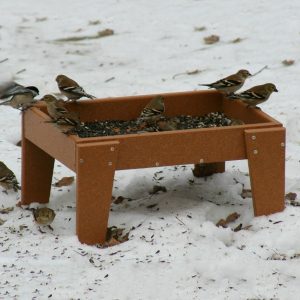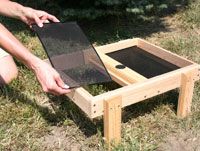Backyard Bird Feeding, Blog - General
Ground Bird Feeder

When I opened the Wild Bird Habitat Stores in 1993, there weren’t any commercially produced ground bird feeders on the market. At first, I just tossed wild bird feed on the ground for those birds that fed primarily on the ground. That included Mourning Doves, towhees, native sparrows, and juncos. Occasionally wood thrush and thrashers would join the group.
But just scattering seed on the ground to attract ground foraging birds, it began to build up becoming a bit of a mess. I thought there must be a better way. I had several old unused wood framed house screens in my garage, so I took one, propped it up on bricks under each corner and there it was, my first ground feeder. It kept the wild bird feed off the ground preventing it from getting wet and spoiling. Then, when all that was left were the shells and the hulls, I’d just go dump it in the garbage and put fresh feed on it. Although my newly founded house screen ground bird feeder wasn’t durable, when it wore out and fell apart, I had a half dozen more unused window screens in my garage to replace it.

When the first ground bird feeders did appear on the commercial market, they had wooden bottoms that didn’t drain water, turning the wild bird feed to a mush after a heavy rain. So, I found a company called Cedar Works in my area that was building bird feeders and showed them plans for a wooden open box with 4 inch legs, 2-inch sides, and a screen bottom. Those ground bird feeders became an instant success.
Since then, numerous bird feeder manufacturers have introduced ground bird feeders with screens or perforated steel bottoms in various sizes. Some have roofs to help protect the wild bird feed from the weather. The box frames of some ground feeders are still made with cedar, but those made with poly lumber, recycled post-consumer plastics, are more durable and have become quite popular. Some even have removable mesh bottoms that make cleaning a breeze.
box frames of some ground feeders are still made with cedar, but those made with poly lumber, recycled post-consumer plastics, are more durable and have become quite popular. Some even have removable mesh bottoms that make cleaning a breeze.
Today at the Wild Bird Habitat Stores we offer many ground feeders in all different sizes, made from various materials, some with roofs, some without. All have perforated metal bottoms for drainage. Ground feeders have evolved into one of the seven basic backyard bird feeders for a complete all-around bird feeding program.
When it comes to adding a ground bird feeder to a backyard bird feeding program customers often ask, “what wild bird feeds are best for ground feeders?” It depends on your situation. Ground feeders are excellent for using a general wild bird mix, but if you have squirrels, they will be attracted to the black oil sunflower seed and peanuts in the mix. That’s fine if you don’t mind the squirrels sharing. I recommend deterring the squirrels by using white Proso millet mixed with safflower or Nutra afflower seed. The millet is attractive to the smaller sparrows while safflower seed is attractive to Mourning Doves.
As for location, don’t tuck it under thick shrubs where predators can lurk. More along the edge of woody habitat. Out in the open is just fine. I have even placed ground feeders under hanging bird feeders to catch dropped debris and uneaten seeds. Those uneaten seeds keep the ground feeder replenished for those ground foraging birds.
Native Sparrow or House Sparrow?

I could always tell, even from a distance, if that little brown bird foraging on the ground in my backyard was a native sparrow or just the common house sparrow. First off, that common house sparrow (English sparrow) is not a true sparrow at all but a weaver finch introduced into North America in the mid-1800s. As such, it has a different feeding habit than do our native sparrows. House sparrows sweep the ground with their beak to turn up seeds. On the other hand, all our native sparrows; White-crowned, White-throated, Harris’, Tree, and Song Sparrows to name a few, scratch the ground with their feet to turn up seeds. So next time you see a little brown bird feeding on the ground, or on your ground feeder, watch their feeding traits. If they are scratching with their feet you want to take the time to identify them. They are native sparrows.
So add a ground feeder to your backyard bird feeding program. You’ll attract more ground foraging birds, have less of a mess, and you may even see the opportunistic Northern Cardinal pay a visit.
